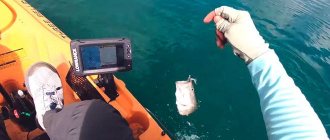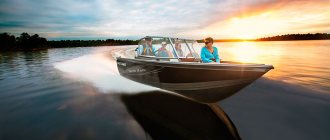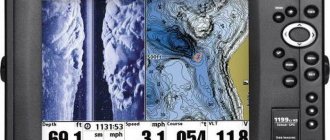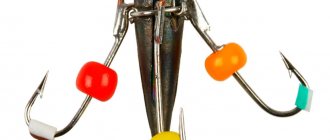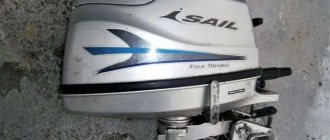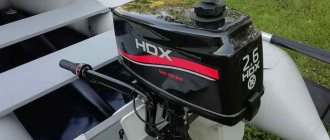Fish can be caught in many ways, but fishing from a boat is the most interesting, both in terms of convenience and in terms of increasing opportunities. Having a boat means using the reservoir one hundred percent, since there are places inaccessible for fishing from the shore.
Boats have different characteristics, they can be wooden, metal, plastic, etc., but it is desirable that they have a motor. The presence of a motor will help you avoid certain troubles and bring some comfort to the fishing process.
An outboard motor is a good option, as it saves the usable space of the boat, and its dismantling is easy, which makes it possible to store the not very cheap unit in a more secure place.
History of the creation and modernization of outboard boat motors
The first mechanical motor for an outboard boat was invented by the American Thomas Rees back in 1866. The propeller in it was rotated manually, and the scheme he proposed for installing the engine on the transom is still in use today. The lead in the invention of its brother with an electric motor belongs to the Frenchman Gustav Trouvet, who proposed such a design 15 years later.
And only by 1909, the American Ol Evinrude established the industrial production of gasoline outboard boat motors, which served as the impetus for the rapid motorization of small-displacement vessels.
Outboard motors made in the USSR/Russia[edit | edit code]
Motor "
Veterok-8
» (
UMP
, USSR, 1980s), left. Without casing, starter removed.
You should keep in mind the difference between domestic and foreign markings of motor models and determination of their power. Until recently, domestic outboard motors were produced with the maximum power at the engine shaft
, and all foreign ones - directly
on the propeller
or
propeller shaft
. Therefore, taking into account losses (in the gearbox, etc.), domestic motors may have lower power on the propeller shaft (which actually “push” the boat) than “similar” foreign models. Therefore, when comparing motors, you should always clarify what kind of power we are talking about.[2]
Outboard motor design
Since their inception, outboard motors have been constructed with components placed vertically. The engines are located in the upper part and are connected by their housing to the deadwood (intermediate housing). The crankshaft is located vertically, equipped at the top with a magneto (generates electricity) and a starter (used to initially start the engine).
A continuation of the crankshaft is a vertical shaft located inside the deadwood. The intermediate housing houses the rods that control the gearbox and the tubes that supply water to the motor for cooling.
At the bottom, the vertical shaft is connected to a reduction gearbox that transmits rotation to the propeller. For units with a capacity of 5 hp. Gearboxes are installed equipped with clutches and usually provide reverse (reverse). The latter, according to standards for outboard motors, is mandatory for engines with power exceeding 12 hp.
The connection between the propeller of the outboard motor and the output shaft of the gearbox is made through a fuse. This is a key, a cut pin, a special rubber bushing, and a safety clutch. It has limited strength and, breaking, keeps the motor intact when the propeller comes into contact with any underwater obstacle.
There are several mounting schemes for outboard motors to the transom: rigid, swivel, tilt and swing-out. The latter, according to reviews, is used most often in outboard motors, as it provides the engine with the ability to rotate around a vertical and horizontal axis.
There are two control schemes for outboard motors: tiller and remote. In the first, this is done through the tiller (handle), located in front of the engine, in its upper part. It also houses the “Stop” button and the gas handle, which regulates the fuel consumption of the outboard motor. Powerful motors are equipped with remote control. The system includes special cables (string cables) or hydraulic and electrical servomechanisms.
Gasoline is usually supplied to the engine through a hose from a tank, which is located separately in the boat. On some low-power outboard motors it may be built into the hull.
Manufacturers of outboard motors are improving their products, trying to create additional comfort for passengers with their help. To do this, engines are equipped with additional devices: electric generators (supply boats with electricity), electric starters, hydraulic pumps, compressors, bilge pumps, boilers, speedometers, and instrumentation.
What is the difference between two-stroke and four-stroke outboard motors?
Another important characteristic of the engine is how many times the cylinder piston is lowered in one cycle. This determines how the cylinder chamber is cleaned of exhaust gas and filled with fuel: simultaneously or in two stages.
According to this parameter, engines are divided into two-stroke and four-stroke.
Two-stroke engines weigh less and, due to their simpler design, are easier to maintain. They are not picky about the quality of fuel.
With the same engine size, a two-stroke will be slightly more powerful than a four-stroke.
Another plus is that two-stroke engines are 30–40% cheaper. But at the same time, they are noisy and consume 20% more fuel than four-stroke engines.
In addition, due to the tendency of spark plugs to become oily, they operate unevenly, especially at low and idle speeds. Although on modern models, manufacturers try to reduce all these disadvantages to a minimum.
Most low-power outboard motors (2.5–4 hp) are made two-stroke. Although such a system can be found on models with power up to 250 hp. And for four-stroke engines there are no restrictions on power.
Primarily due to their efficiency, four-stroke engines are much more popular. In addition, they are quieter and more environmentally friendly.
They have a more complex design, so they are heavier and their maintenance is not as simple as servicing two-stroke engines.
Four-stroke engines are also more demanding in terms of fuel quality. But they do not require mixing gasoline with oil.
This, however, causes problems during transportation.
If a two-stroke engine can be transported in any position, then four-stroke engines can be transported either vertically or on one specific side.
If you do not follow these recommendations, oil will enter the combustion chamber and flood the spark plugs (and then the trunk of the car).
In addition, because of this, an oil change after every 100 hours of operation is added to the maintenance of a four-stroke engine.
Reviews of outboard motors from foreign manufacturers
The market for outboard outboard engines today is represented by a large number of products from different manufacturers. Among the brands known to compatriots are Yamaha, Suzuki, Mercury, Tohatsu, Honda, Nissan marine, Hdx, Hangkai, Sea Pro, Neptune, Salyut, Parsun, Johnson, Shmel, Hidea, Jet, Gulfstream, Sailor, Gladiator, Zongshen, etc.
Some of the craftsmen are trying to make such engines themselves, making, for example, a motor from a chainsaw. And, by the way, it turns out quite well.
Yamaha
Yamaha Corporation (Japan) has been in the outboard motor market for several decades. During this time, it sold almost 7 million units in different regions of the Earth. The company is one of the most representative suppliers of motors to many countries around the world.
The line of engines produced under the Yamaha brand consists of more than two hundred varieties. All of them are united in the main 4 series: “Four Storke”, “Hi-Tec”, “Enduro”, “Original”.
Units of the “Hi-Tec” and “Original” series are two-stroke outboard motors. Their power range is 250…2 hp. The first is equipped with many additional equipment, while the second has minimal equipment. The advantages of Yamaha engines are the separate supply of fuel (gasoline) and oil to the cylinder.
The remaining two series (“Four Storke”, “Enduro”) are 4-stroke outboard engines with all their advantages, the latter being designed and manufactured for heavy, demanding operating conditions. It is these models that are purchased more for sports purposes.
According to available reviews, Yamaha engines are compact, have optimal placement of components and parts, and are light in weight. Their advantages include innovative technical and technological solutions.
2-stroke engines of the Yamaha brand, due to their proven operation over many years, safety, small size, and budget price, are in demand by domestic buyers. They are highly repairable, require minimal maintenance, are simple in design, and are easy to transport.
Yamaha four-stroke units, for which they were created, have an increased service life, better environmental characteristics, and minimal noise. The modernity of the products is emphasized by the use of microcomputers in control systems. In the characteristics of any Yamaha engine, fuel consumption is the lowest among its analogues.
Nissan marine
This type of engine is little known in Russia. They are made in Japan and, like all other series from the brand, are presented in a line of 2-stroke (NS, NSD series) and 4-stroke (NSF, BF series) products. Among the units produced by the company are TLDI injection boat engines equipped with a gasoline injection system.
Nissan Marine engines are similar in basic characteristics and parameters to Tohatsu brand units. There are differences in the configuration of the engines and their design. There are exceptions to the line - the “BF” series, developed together with engineers.
The advantages of the Nissan Marine brand are the unpretentiousness of the mechanisms and their endurance. The reliability of the design is increased by galvanizing all surfaces in contact with water, making water pump housings from stainless steel, and installing a rubber impeller in the pump with a larger gap than usual. The latter has a particularly positive effect on the operation of units in silted, littered water.
Nissan marine is a brand under which the company produces units with one (model “NS3.5A2 1”, 3.5 hp), three (40 hp) and four (120 hp) cylinders. The more “strong” ones come with electric trimmers, which supply additional electricity on board the vessel.
The latest models of two-stroke engines are produced by Nissan with fuel injection into the cylinders, which has greatly reduced fuel consumption and brought this indicator closer to their 4-stroke counterparts. And having less weight and more power, they became real competitors for the latter.
The company’s 4-stroke engine models cover the power range of 225…2 hp. Among the most purchased by compatriots today are single-cylinder carburetor-type units of 4.0 and 6.5 hp. The latest three-cylinder products are of the injection type and can be started manually.
Nissan marine engines with up to 4 horses have built-in gas tanks. For more powerful units, gasoline is supplied from a separate canister.
Mercury
Mercury brand outboard motors have been produced (USA) for more than 8 decades. Today, a network of technical centers for the sale, maintenance, and repair of units has been formed around the world, which has added credibility to the brand and significantly increased the level of sales.
Today, based on reviews, the Mercury boat engine is one of the most popular and best-selling on the market. All this has been achieved through years of painstaking work to improve products and a constant focus on innovative solutions. The latter is a feature of the company, because its models constantly contain something new, which will then become mandatory for other manufacturers.
The range of motors produced by the company is extensive. Here is a 4-stroke unit of the Verado brand, which received a drive air supercharger, which brings it closer in power to its 2-stroke counterparts. Here is the “EFI” series, equipped with a direct gasoline injection system. And models of the Optimax series, which have such direct injection into the cylinders.
Products from the Mercury brand are being bought up by amateur boaters and professional racers. It is on them that the latter reach the heights of their sports careers. Confirmation of this: Guido Cappellini is a Formula 1 driver and multiple winner; Swedes' circumnavigation of the world on a boat equipped with a Mercury 4-stroke unit, etc.
The company also produces outboard water-jet outboard motors. Their features make it easy to overcome shallow waters and rapids in reservoirs. The characteristics are sometimes superior to screw units.
Among the best models of the company are specialists from the latest models about. It is in it that everything new that has been invented today by Mercury engineers is concentrated. The unit has a modern, functional appearance, has electronic injection, is lightweight, and differs from its counterparts in its increased reliability and endurance. Plus, reduced fuel consumption and ease of maintenance.
Tohatsu
Tohatsu is a company that was the first in Japan to produce outboard gasoline engines. The first-born (OV-2, 1.5 hp) was released in 1956 and became a unit that began to influence the formation of the global outboard motor market.
The features of Tohatsu products are reliability, despite the difficult working conditions. This is achieved by production control (in the company’s special pool) of all components and parts before launching into series.
The main specialization of the company is two-stroke engines. They feature low pressure and direct injection of gasoline into the cylinder, which reduces fuel consumption, the amount of oil added to the Tohatsu, and reduces harmful emissions to the outside. As a result, engines today are practically in no way inferior to 4-stroke products.
According to its characteristics, the M 2.5 model is one of the smallest models among Tohatsu products. However, it has an electronic ignition system, a specially designed fuel pump (with a return loop), which allows for minimal gasoline consumption. The height of convenience in the unit is the presence of a carrying handle and the ability to turn around.
One of the most popular among customers, according to reviews, is the Tohatsu engine of the “18 C EPS” brand. It is convenient for medium-sized boats and is purchased by owners of small yachts. Has sensors for overheating and oil pressure. You can use it to recharge batteries and other electrical appliances. It is installed with manual control and remote control.
Suzuki
The list of suspended-type Suzuki models includes products with 2.5…300 hp. power. Among them there are 2-stroke and 4-stroke, they can be equipped with different types of ships.
The company is constantly searching for new technical solutions for its products and therefore today is a leader among manufacturers of four-stroke engines equipped with electronic injection. This is confirmed by constant awards at various competitions in which the company’s units take part.
One of the best indicators of the prestige of the company’s products is the fuel consumption of Suzuki engines, which is actually lower than that of competitors’ units. And this was achieved by the company’s phased multipoint electronic gasoline injection, which is the most advanced innovation among such products today.
The high rating of Suzuki brand products is supported by their reliability, the use of time-tested technologies, and mandatory testing of all innovations for the level of toxicity of emitted gases. The units are equipped with numerous sensors that report engine malfunctions and help to quickly eliminate them.
Suzuki is constantly using new materials. This consistency in operation has led to the fact that the company’s 4-stroke units are the lightest and most compact in their class.
The advantages of Suzuki products are the ease of adding oil to a gasoline boat engine, ease of maintenance and control. Today they are equipped with powerful generators, which already at low speeds produce enough electricity used for various purposes. The advantages of Suzukov units also include the lowest noise level during operation.
Review of outboard motors by types and types
Suspended petrol
The first gasoline outboard engines appeared in 1909. The creator of these engines was the American Olom Evinrude. Today, the production of these motors continues and their choice is quite wide - there are 26 modifications.
Nowadays, you can see that the bulk of outboard motors are built according to the scheme that Evinrud proposed back in 1906. That is, in this case we mean a vertical arrangement of all parts. The engine is located at the top of the housing, and the crankshaft runs vertically downwards. The lower part of the intermediate housing serves as a mount for the gearbox, which transmits rotation to the propeller.
Gasoline is supplied through a hose that connects the remote tank to the engine. Only engines with low fuel consumption are equipped with a built-in gas tank.
How to choose a motor for a boat? First, you need to pay attention to the type of vessel. Outboard motors vary in length of the “leg” (deadwood). This length depends on the design of the boat. The length of the transom is also important, which can be 380-635 mm.
The motor can be mounted in different ways. If the mount is rigid, then this means a fixed fixation on the transom. When using a rotating suspension, the motor can move along a vertical axis. The optimal suspension is a tilt-and-turn one, which improves boat control. The use of this suspension softens the impact of an obstacle, which is associated with tilting the engine. The best suspension is considered to be one that is made of elastic materials that can reduce the level of vibration on the hull of your vessel.
According to the controls, boats are divided into tiller-operated and remote-controlled. Tiller motors imply the presence of a handle (tiller) that is connected to the motor. If the steering wheel is located in the center of the vessel, then we can talk about remote control.
The type of start also influences the choice of motor. As you know, the engine is started using a cable or starter. If starting is carried out using a starter, then for this the engine must be equipped with an electric ignition system and, accordingly, there must be an ignition switch, as well as a battery.
Before choosing a motor, you need to pay attention to its power, and you should correlate it with what engine power is provided for your type of boat. Usually the power is indicated on the engine cover.
In addition, you should pay attention to the types of outboard motors. Outboard motor options are divided into two-stroke and four-stroke. The former have a working cycle of two strokes and have a simpler design, and are also small in size and light in weight. The cheapness and undemanding quality of gasoline maintains sufficient demand for two-stroke engines. In turn, four-stroke engines have a longer service life, and they are much more economical in terms of fuel consumption.
When choosing a boat motor , you need to understand the power markings, which differ depending on the manufacturer. On Russian units, maximum power figures are indicated, and in this case this means the power at the engine shaft. As for foreign manufacturers, the marking of motors means the power that is created on the propeller or propeller shaft. Based on this, Russian engines have less power.
Since the main characteristics of outboard motors are known, it is worth moving on to choosing a manufacturer.
Yamaha
Yamaha is one of the most famous brands. The model range of this brand is represented by seven main types of motors, which have more than 200 modifications. Only four series are supplied to Russia, starting from Enduro and ending with the simpler Original version. And the HI-Tec series is distinguished by separate fuel supply and a good selection of additional equipment.
Mercury
The Mercury brand has the advantage of a wide range of models. It is also worth noting the high reliability of engines of this brand. Two-stroke engines are easy to operate and engines with power from 2.5 to 30 hp can be found on sale. Four-stroke engines have power from 40 to 250 hp. The engines of this brand have a unique gear shift system.
Suzuki
Suzuki engines, according to some professionals, are among the best in the world. This formulation relates to four-stroke engines of this brand. This fact is due to increased reliability, low noise level and low fuel consumption. Expensive models are equipped with an on-board computer, which optimizes electronic injection, which leads to greater fuel economy.
Tohatsu
Tohatsu can be considered a leader in the production of two-stroke engines. Models of this brand are reliable, they have an optimal power-to-weight ratio. These motors are developed in accordance with environmental standards. Tohatsu two-stroke engines, according to experts, are the most reliable of their kind.
Vortex
The cheapest models include domestically produced samples, and in particular the “Whirlwind”, which are produced in several modifications. The design of these models is a classic two-stroke engine design. Positive qualities include: high power, low price, maintainability and no problems with spare parts. In turn, the list of disadvantages is quite extensive: noise, high fuel consumption, the possibility of engine fire, etc.
Two-stroke
A two-stroke outboard motor involves combining the exhaust phase of the used mixture and the intake of fresh mixture. In this case, exhaust gases are displaced using fresh working mixture. This circumstance increases fuel consumption and at the same time the level of harmful emissions increases. This is because in a two-stroke engine, oil is added directly to the gasoline.
The positive aspects of these motors are their low price, compact size and easy repair, which is important. You can also note the unpretentiousness to domestic 92nd gasoline. And if you make certain adjustments, the two-stroke engine works great on gasolines such as A-76 and A-80.
The service life of a two-stroke engine can be up to 10-12 years. That is, in principle, the motor requires only one overhaul during its entire service life. Therefore, you can get a unit that will last 15-20 years.
Which engine should you buy: domestic, Japanese or Chinese? If you have the opportunity to spend money, then you should opt for Japanese engines, as they are all of high quality.
The Chinese manufacturer aims to clone Yamaha products. Chinese clones differ from the original models in assembly and quality of material. In general, we can say that Chinese outboard motors ideally correspond to such parameters as price/quality. In some characteristics, Chinese products are clearly superior to motors from Russian manufacturers, but at the same time they do not match the quality of the original.
Based on the foregoing, the following characteristics of a two-stroke outboard engine can be distinguished:
- simple design;
- compact dimensions;
- maintenance is not only simple, but also cheap;
- can quickly gain momentum;
- due to its small size, it is convenient for frequent transportation;
- low price, which is determined by the simplicity of the design;
- light weight.
Four-stroke
The main distinguishing feature of a four-stroke engine is fuel combustion. That is, combustion occurs in four stages: fuel is sucked into the combustion chamber, it is compressed, combustion occurs, and exhaust gases are removed. Unlike a two-stroke engine (oil is added to gasoline), a mixture of fuel and air is burned in the chamber. The oil in this case is in an isolated system.
Thanks to this, the four-stroke engine allows significant fuel savings. It can also be noted that this type of engine works quite well at low speeds. This condition is ideal for fishermen, since in this mode the engine runs very quietly. And efficient fuel combustion allows us to talk about cleaner exhaust, which affects the environmental performance.
Advantages of a four-stroke engine:
- great resource;
- fuel savings (about 40%);
- less harmful emissions;
- quiet operation;
- It is stable when operating at low and idle speeds.
As for the downsides, it is believed that it is not repairable while on the road. This statement is justified, since this engine is more complex from an engineering point of view. True, if you purchase a good imported unit, then its breakdowns are quite rare.
Disadvantages also include its difficulty in transportation and storage. This is due to the oil that is in the engine. To prevent oil from leaking, motors of this type must be transported either vertically or on one specific side.
Another indicator such as weight is noted. But this figure is controversial, since the average weight of a four-stroke engine is on average greater than the weight of a two-stroke engine, by only 7-10 kg. If we talk about the feasibility of four-stroke engines, then their useful use begins with Yamaha (40 hp) and Honda (50 hp). When choosing weaker engines, you should pay attention to the two-stroke version of the engine.
Water jet
Jet motors are designed to use the boat in places where the use of a screw version is impossible, for example, shallow water.
The principle of operation of a water cannon is based on the fact that a vacuum occurs, which is created by the impeller, and water rushes through the receiving pipe. Then the water is released through the nozzle, which in turn sets the boat in motion. Turning the nozzle allows you to turn the vessel, and closing it makes it possible to reverse, as the water stream begins to flow in the opposite direction.
Boats with water jet engines are more stable due to the fact that the water jet “sucks” the boat to the water. Water cannons are also easy to repair. Plus, this type of motor is safe, since the impeller is located inside the housing and there are no moving parts outside.
Water jet engines are either stationary or outboard. What are the advantages of outboard jet engines?
they can be installed on any vessel and the transom does not need to be modified for this;
- are reliable in terms of operation;
- the water jet attachment can be easily dismantled;
- safe in water;
- They are easy to repair and maintain.
What power should an outboard motor have?
Modern outboard engines range in power from 2 to 450 hp. (Mercury Racing 450R). There is also the Seven Marine 627SV, whose power is 627 hp, but in the fall of 2021 the Volvo Group, which includes the brand, announced that it was going to stop producing them.
Engine power depends on two main parameters: the number of cylinders and displacement. Displacement is also referred to as the "displacement" of an engine. This is the sum of the working volumes of all cylinders, which are calculated based on their cross-section and the length of the piston stroke. Displacement shows how much fuel an engine can burn in one cycle.
If a manufacturer wants to increase engine power, he has two options: increase the number of cylinders or increase their volume.
The tiny Yamaha has 2 DMHS with 2 hp. only one cylinder and a displacement of 50 cm³ (0.05 liters). The powerful Mercury Racing 450R has 8 cylinders and a displacement of 4.6 liters. For comparison, an engine of the same displacement is used in BMW x5 cars.
The engine cylinders can be located either on one side or opposite each other, at an angle (then the letter V appears in the model name).
How many horses a boat can “hold” depends on each specific model. Moreover, overdoing it and putting an overly powerful motor on a boat is no better than putting an underpowered one. If the engine power is too high, the transom on which the engine is mounted may collapse or become detached from the hull.
The shipyard always tells the future owner what minimum and maximum engine power the boat is designed for.
The optimal ratio is 1 hp. for every 20–25 kg of loaded boat weight.
For small, basic RIBs and PVC boats, tiny 5hp outboards are often sufficient.
Although even in this case, maximum power and body length are not always in tandem. For example, the 3-meter RIB Brig Falcon 300 comes with a Honda BF outboard engine with 4 times more power - 20 hp. (although the owner can opt for options with a power of 4–15 hp.) The 4-meter RIB Boston Whaler 130 Super Sport is equipped with a Mercury ELPT EFI with a power of 25–40 hp.
On the 5-meter aluminum fishing boat NorthSilver 545 Fish, the maximum engine power already exceeds a hundred and reaches 115 hp.
The 6-meter fiberglass bowrider Jeanneau Cap Camarat 6.5 BR in its maximum configuration boasts a Yamaha F200 FETL with 200 hp. The minimum for this model is 130 hp. We increase the length of the hull by another meter, and we find up to 250 “heads” “in the herd” of the 7.1-meter aluminum boat Volzhanka Voyager 700.
On 8-meter boats (for example, a boat with a Chris-Craft Catalina 27 center console) they already install almost the most powerful outboards - up to 425 hp. Although on this model you can limit it to 200 hp, up to an absolute maximum of 450 hp. for one engine, such a boat is very close.
The most powerful suspensions are already found on the 9.6-meter “off-road” with a trawler house Grizzly 960 Unimog. It needs a total of 900 hp, and this is achieved by installing either a pair of 450 hp engines or three 300 hp engines.
Electric boat motors
An electric boat motor has a design that is similar to low-power gasoline options. In this case, the engine is not located at the top, like in gasoline engines, but at the bottom, where the propeller is located. Thus, the engine is located under water.
The power source for electric boat motors is batteries. Their power is relatively low (0.5-1 hp). Although there is no such thing as horsepower in relation to electric motors. Instead, the term “thrust” is used, that is, the force that an electric motor can develop. This indicator is measured in pounds (kilograms), and it depends on displacement.
Electric motors are mainly used in calm water. If you are going to reach speeds above 5 km/h or will be moving against the current, then you should buy a gasoline engine.
The electric motor can be perceived as an alternative to rowing, and it is also practical in terms of silence, which is a plus for fishing.
Disassembly and analysis of the condition of motor components
Remove the engine trim and front panel. I have already described how this is done in the article “Tuning a Fisher 2.5 outboard motor, part one.” fish-hook.ru/ar…hast-501/
Disconnect the fuel hose from the carburetor. Unscrew the three bolts securing the fuel tank and remove it.
We mark with a marker the position of the gasket relative to the motor head. Remove the candlestick and unscrew the candle.
The candle is in good condition. After running in the engine, I never unscrewed it. There just wasn't a need.
Unscrew the four bolts securing the head and remove it.
There is a slight black coating on the inner surface of the head, which can be easily removed.
The piston surface is completely clean and free of carbon deposits. Not expected. I expected to see at least some carbon deposits. Most likely, this is due to the engine oil. Now, if I used “folk” M-8 oil, I would notice a lot of unsightly things.
The cylinder walls are clean, without scoring.
The arrow indicates the location to which the piston rings reach when the piston is at top dead center.
Here I expected to see a difference between the working and non-working parts of the cylinder, but I found nothing! It felt like the piston was working without touching the cylinder! But looking at these scratches, it seems that Chinese workers honed the cylinder by hand using coarse sandpaper. Now, let's look into the engine, through the exhaust window.
The piston pin is secured with retaining rings. Cylinder liner installed correctly. The cylinder block does not block the exhaust port in the liner. It may seem that in the lower corners, the window in the sleeve slightly overlaps the window of the block, but this only seems to be due to the acute shooting angle.
By lowering the piston down, a view of the piston rings opens up.
And here I saw a rather interesting picture: the piston rings were made of different metals. The lower ring, as expected, is most likely made of gray cast iron. But the top one is made of some white, shiny metal. The edges of the upper ring groove have slight bevels. The bottom groove has no bevels.
But that's not all. Having measured the width of the grooves of the rings with a marking compass, I found out that the upper ring is narrower than the lower one. That is, it will not be possible to swap them. The upper ring will dangle in the lower groove, and the lower one simply will not fit into the upper groove. This is the first time I've encountered this.
During operation, the upper piston ring experiences greater thermal and mechanical loads than the lower one. Therefore, it is probably made of high-strength cast iron alloyed with chromium or nickel. Unlike gray cast iron, it has the properties of steel: it is not brittle and under heavy loads it deforms without breaking. But I don't know much about metals. If all this is true, then how can we not give Chinese manufacturers a big plus!
You can notice that the upper ring had a spherical surface, and was not yet lapped with the entire plane. And on the lower ring, the lapping marks have not even been erased. After a season of operation, the condition of the rings is as if they had just been run-in. This makes me happy too.
The connecting rod does not have brass bushings, but roller bearings. And that's good too.
The crank mechanism is in perfect order. I did not disassemble it any further. If the piston with rings, crankshaft and connecting rod bearings are normal, then I do not recommend getting into this unit.
